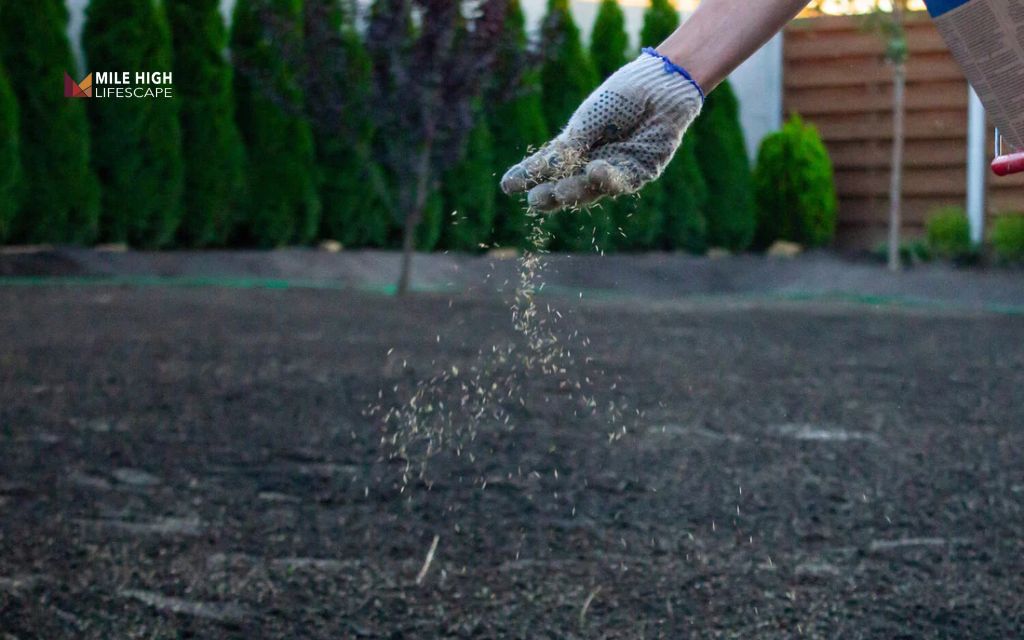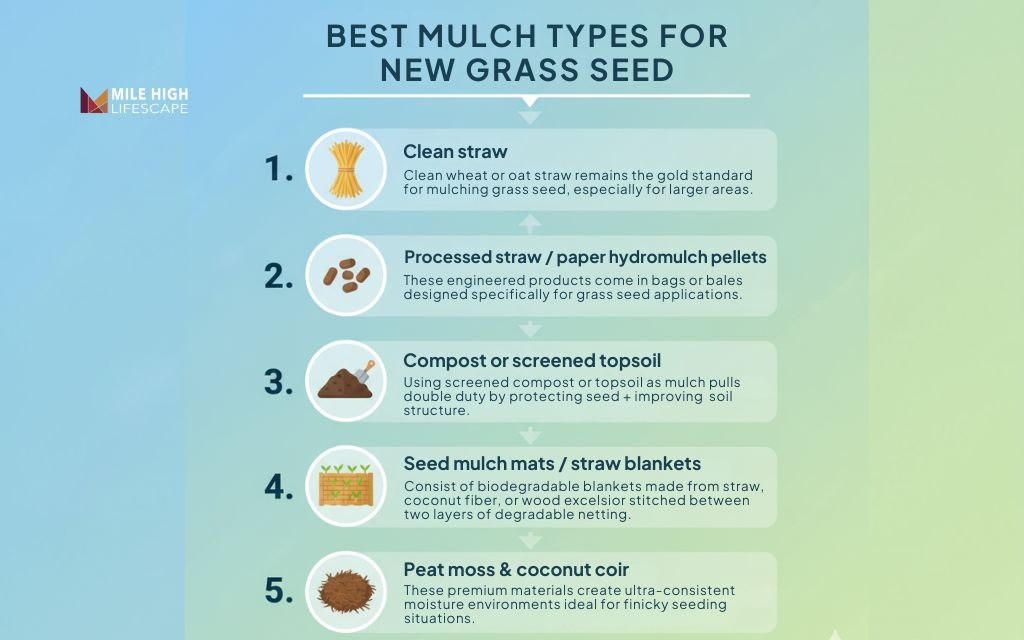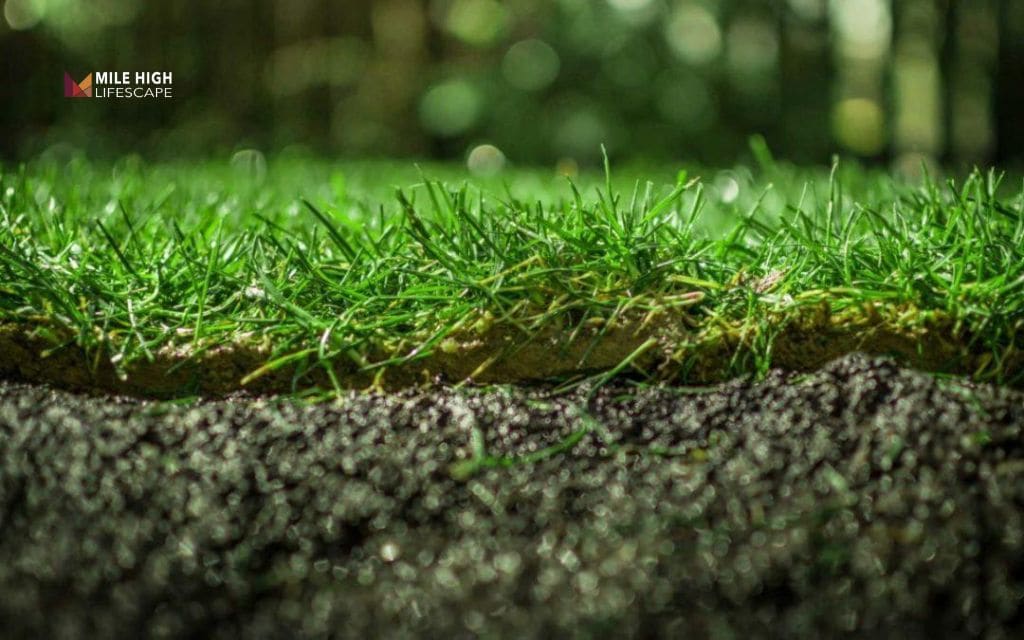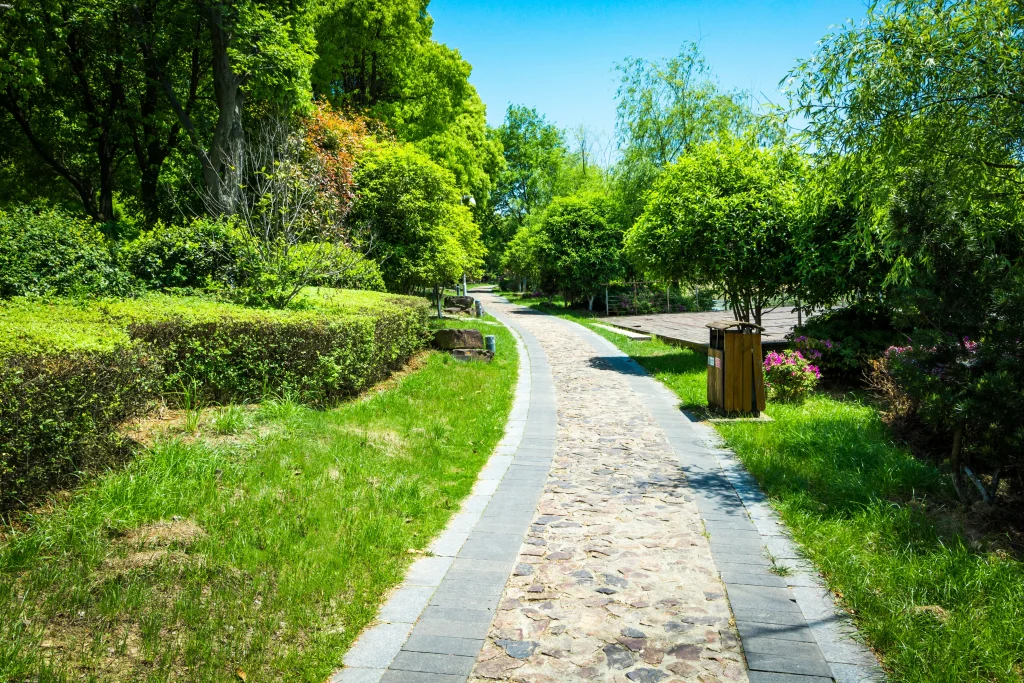Mulching new grass seed creates a protective microenvironment that does four critical jobs simultaneously. It shields vulnerable seeds from intense UV rays, locks moisture, stabilizes soil temperature, and creates a physical barrier against the elements. When done correctly, this simple layer can boost your germination rates from frustrating to a thriving.
This guide shows you how to mulch over grass seed correctly for Denver conditions. You’ll learn which mulch types work best at altitude, how to apply coverage that protects without smothering, and how to time watering with our weather patterns.
The difference between patchy disappointment and thick turf comes down to understanding these specifics.
Mulching new grass seed 101
What “mulching new grass seed” really means
Mulching new grass seed involves applying a thin protective layer of organic or biodegradable material directly over freshly seeded soil. This isn’t the same as the decorative mulch you’d spread around shrubs or in flower beds.
- Mulching a newly seeded lawn uses lightweight, seed-friendly materials applied in thin layers (½ to 1 inch) that allow grass blades to push through easily.
- Mulching around established grass or landscape plants uses heavier, long-lasting materials like shredded bark or wood chips in 2-4 inch layers designed to suppress weeds and retain moisture for months or years.

How mulch helps grass seed germinate
The science behind mulching new grass seed comes down to 5 benefits:
- Moisture retention: Mulch acts like a sponge-and-umbrella combination, absorbing water during irrigation and then slowly releasing it while simultaneously shading the soil surface to slow evaporation.
- Erosion control: Erosion control keeps your seed where you planted it. When thunderstorms dump intense rainfall on bare tilled soil, water rushes across the surface carrying topsoil and seed with it. Mulch breaks the impact of raindrops, allowing water to infiltrate slowly rather than running off.
- Temperature regulation: Temperature regulation creates stable conditions for germination. Grass seed needs consistent soil temperatures but Denver’s spring and fall days can swing 40 degrees from morning to afternoon. Mulch insulates against these extremes, keeping soil cooler during hot afternoons and warmer during cold nights.
- Bird and critter protection: Mulch hides individual seeds from view and makes it harder for birds to efficiently scratch and feed. Squirrels and chipmunks are less likely to dig through mulched areas compared to exposed seed lying on bare soil like a convenience store.
- Gentle weed suppression without herbicides: Mulch blocks light to these weed seeds while letting grass seedlings push through. This gives your grass a head start without herbicides that could damage new turf.
Best mulch types for new grass seed in Denver
Clean straw
Clean wheat or oat straw remains the gold standard for mulching grass seed, especially for larger areas. When you see professional landscaping crews seeding commercial properties or sports fields, they’re almost always using straw.
Pros:
- Straw checks every box for budget-conscious Denver homeowners. At $8-15 per bale covering roughly 500-1,000 square feet depending on thickness, it’s the most economical option.
- It’s readily available at every garden center and farm supply store along the Front Range.
- The hollow stems trap air for excellent insulation while allowing water and light to penetrate easily.
- As it breaks down over the first growing season, straw adds organic matter to your soil.
Cons:
- Regular farm straw often contains weed seeds that will germinate right alongside your grass, creating extra work later.
- Look specifically for “weed-free” or “certified clean” straw, which costs slightly more but saves headaches.
- Loose straw can blow around. Without some anchoring, you might wake up to find your mulch decorating your neighbor’s yard.
Processed straw / paper hydromulch pellets
These engineered products come in bags or bales designed specifically for grass seed applications. Brands like Penn Mulch or EZ Straw consist of processed paper fibers or finely chopped straw that expands when wetted, creating uniform coverage without the mess of loose straw.
Pros:
- Processed mulches eliminate weed seed concerns since they’re manufactured from clean materials. They provide more uniform coverage than loose straw.
- The compressed pellets or shredded material is easier to transport and store than bulky straw bales.
- Many formulations include a tackifier that helps the mulch stick to slopes and resist wind.
Cons:
- Expect to pay 2-3 times more than raw straw.
- These products require careful watering because they can form a crust if allowed to dry out completely, which then sheds water rather than absorbing it.
- You’ll need to follow package directions precisely for both application rate and watering schedule.
Compost or screened topsoil as seed mulch
Using finely screened compost or topsoil as mulch pulls double duty by protecting seed while simultaneously improving your soil structure. This approach works especially well when renovating tired lawns on Denver’s clay soils.
Pros:
- High-quality compost adds nutrients that feed seedlings as they establish, potentially eliminating the need for starter fertilizer.
- It improves soil structure by adding organic matter that helps clay drain better and sandy soils retain moisture.
- When applied lightly, compost creates excellent seed-to-soil contact while still providing surface protection.
Cons:
- The line between “just right” and “too much” is razor-thin. Apply compost too thickly (more than ¼ inch), and you’ll smother seedlings before they emerge.
- The material must be finely screened – no chunks or clumps larger than rice grains – or it won’t spread evenly.
- Quality matters tremendously; poor compost may contain weed seeds, excessive salts , or unfinished material that ties up nitrogen as it decomposes.
Seed mulch mats / straw blankets
These engineered products consist of biodegradable blankets made from straw, coconut fiber, or wood excelsior stitched between two layers of degradable netting or bonded together with adhesive. They come in rolls typically 4 – 8 feet wide and 50-100 feet long.
Pros:
- For erosion control on slopes, nothing beats the performance of straw blankets. They’re champions for storm-prone spring season and anywhere water runoff threatens to wash away seed and soil.
- The blankets stay put in winds that would scatter loose straw across the neighborhood.
- Installation creates intimate seed-to-soil contact while the blanket surface catches and holds moisture.
Cons:
- Cost potentially 10-20 times more than straw for equivalent coverage.
- Installation is labor-intensive, requiring you to unroll blankets, cut around obstacles like sprinkler heads or trees, and stake or staple them every few feet to prevent lifting.
- The extra effort and cost only make sense where erosion is a genuine threat.
Peat moss & coconut coir
Both peat moss and coconut coir (made from coconut husk fibers) excel at holding water – peat can absorb 10-20 times its dry weight, while coir manages 8-10 times. These premium materials create ultra-consistent moisture environments ideal for finicky seeding situations.
Pros:
- Both materials are lightweight, easy to spread uniformly, and completely weed-free. They create exceptionally consistent moisture conditions with no hot or dry spots.
- Peat moss is widely available at every Denver garden center.
- Coconut coir is more sustainable and doesn’t form a water-shedding crust the way dried peat can.
Cons:
- Peat moss raises sustainability concerns since peat bogs are critical carbon sinks and wildlife habitats being depleted faster than they regenerate.
- It can form a hydrophobic crust if allowed to dry completely, after which it actually repels water rather than absorbing it.
- Coconut coir addresses the sustainability issue but costs significantly more and has limited availability in Denver.
- Both materials offer minimal erosion control compared to straw or blankets.

What NOT to use over new grass seed
Steering clear of inappropriate materials saves time, money, and frustration:
Hay
Hay looks similar to straw but comes loaded with weed seeds, you’re essentially planting a meadow of foxtail, crabgrass, and thistle along with your grass seed. The “cheaper” price evaporates when you spend next summer fighting weeds. Always choose straw over hay.
Heavy bark mulch or wood chips
Heavy bark mulch or wood chips belong in landscape beds, not on grass seed. The coarse pieces create thick barriers that physically prevent grass blades from emerging.
As wood chips decompose, they temporarily tie up nitrogen that your seedlings need, causing yellowing and stunted growth. Bark mulch also retains too much moisture on the surface, creating ideal conditions for fungal disease.
Rock, gravel, or decorative stone
Rock, gravel, or decorative stone might seem logical for erosion control, but they create fatal heat zones in intense sun. Dark rocks can heat soil surfaces 20-30°F above air temperature, literally cooking seeds.
Even if seeds germinate, the rocks block emergence and make future lawn maintenance impossible without removing every stone.
How to mulch new grass seed for maximum germination
Step 1: Prepare the soil properly
- Remove all debris, old thatch, and dead turf first. Rake these materials off the surface. Seed needs contact with mineral soil, not dead plant matter.
- Loosen the top 2-3 inches of soil with a rake or tiller. Compacted soil prevents root penetration. In Denver’s clay soils, this step becomes critical. Hard clay sheds water and blocks roots.
- Add compost to clay or compacted soil. Spread 1/2 inch of compost over the area, then till it into the top 3 inches. This improves drainage and gives roots something to grow through.
- Level the surface and lightly firm it. Walk over the area or use a roller set at light pressure. The goal is firm contact between seed and soil, not concrete hardness. Your footprints should leave only slight impressions.
Step 2: Seed at the right rate with the right mix
Denver needs cool-season grass blends.
- Kentucky bluegrass, perennial ryegrass, and fine fescue perform well at altitude. A typical Denver mix contains 60% bluegrass, 30% ryegrass, and 10% fescue.
- Follow the label seeding rate exactly. Bags specify pounds per 1,000 square feet. Over-seeding wastes money and creates weak, thin-bladed grass that struggles to compete. Under-seeding leaves gaps for weeds.
Step 3: Ensure good seed-to-soil contact
- Lightly rake seed into the soil surface. The goal is to nestle seed into the top 1/4 inch of soil. Seed sitting on top of hard soil dries out and fails to germinate.
- Rolling after seeding improves contact. Use a lawn roller filled 1/3 full with water. Roll in one direction only. This presses seed into soil without burying it too deep.
- Some gardeners prefer tamping with a board or walking the area. These methods work but give less uniform results than rolling.
Step 4: Apply mulch correctly
Target thickness varies by mulch type.
- Straw should be spread 1/2 to 1 inch deep. You should see 50% or more of the soil through the straw stems. Grab a handful of straw, shake it to remove loose pieces, then toss it gently over a 4-6 square foot area. Repeat until the entire seeded area has coverage.
- Paper mulch pellets follow bag directions, typically 3-5 pounds per 100 square feet. Spread the dry pellets evenly, then water immediately to activate them.
- Compost or fine topsoil requires a light dusting only. Apply 1/8 to 1/4 inch maximum. You should still see seeds through the compost. Use a broadcast spreader on the finest setting for even application.
- Straw blankets get rolled out and stapled down. Overlap edges by 3 inches and staple every 12 inches around the perimeter. Staple any areas that lift in the wind.
- Peat moss or coir gets spread 1/4 to 1/2 inch thick. The material should look like a light brown haze over the seed, not a blanket.
Step 5: Anchor mulch against wind & storms
- Light watering locks mulch in place. Water with a sprinkler for 5-10 minutes immediately after mulching. This settles the material and reduces wind problems.
- Slopes require extra anchoring. Use straw blankets with staples for slopes over 15 degrees.
- For gentler slopes, apply a tackifier spray over loose straw. Tackifiers are natural glue products that bind mulch together temporarily.
- Edge mulched areas near sidewalks and driveways. Place a border of rocks or boards to keep mulch from drifting onto paved surfaces during storms.
Step 6: Watering schedule
The first 2-3 weeks determine success.
- The top 1/2 inch of soil must stay constantly damp, not soggy. This typically requires 2-4 light watering sessions per day during hot, dry weather.
- Morning waterings happen between 5-8 AM. Midday waterings occur around 1-2 PM on hot days. Evening waterings take place between 6-8 PM. Each session runs 10-15 minutes to wet the surface without creating puddles.
- Adjust for weather. Cloudy, cool days need fewer waterings. Hot, windy days may need an extra session.
- After germination, taper watering gradually. Once blades reach 1 inch tall, reduce frequency but water longer to encourage deeper roots. Transition to watering once daily for 2 weeks, then every other day.

Timing your seeding + mulching for Denver’s seasons
- Spring seeding runs from late April through early June. Soil warms by late April in most Denver locations. This triggers germination.
- Fall seeding happens mid-August through late September. This window offers the best conditions for Denver grass. Fall rains help with watering. Weed competition drops.
- Summer seeding from late June through early August fights extreme heat and rapid evaporation. Heat stress kills germinating seed faster than you can replace moisture.
- Winter seeding after October fails in Denver. Soil temperatures below 50 degrees prevent germination. Seed sits dormant until spring, exposed to erosion, birds, and rotting.
Troubleshooting: Common mulching & germination problems
| Problem | Likely Cause | Fix |
| Patchy germination on sunny spots | Mulch too thin, hot/dry conditions, insufficient watering frequency | Add more mulch to bare spots, increase watering to 4-5 times daily in hot weather, consider temporary shade cloth |
| Moldy, slimy mulch surface | Mulch too thick, overwatering, poor air circulation | Remove excess mulch, reduce watering frequency, lightly rake surface to improve airflow |
| Seed washing down slope | Loose mulch, no erosion control, insufficient anchoring | Install straw blankets with staples, apply tackifier spray over straw, add temporary barriers at bottom of slope |
| Birds still feasting on seed | Mulch too sparse, seed not raked in, visible seed attracting wildlife | Rake seed deeper, add heavier mulch layer, use bird netting for first week |
| Seedlings yellowing after emergence | Nutrient deficiency or overwatering causing root stress | Apply starter fertilizer at half strength, reduce watering frequency but water deeper, check soil drainage |
Conclusion
Growing grass in Denver is not impossible. The altitude, dryness, and storms require adapted techniques. Success comes from combining good soil prep, the right seed mix for cool-season grasses, thin and even mulch coverage matched to your site conditions, and a watering schedule that accounts for Denver’s weather.
For professional assistance with seeding, mulch installation, or complete lawn renovation, Mile High Lifescape has served the Denver Metro area for nearly two decades. Our team understands altitude challenges and water-wise practices.
Contact us at (303) 877-9091 or hello@milehighlifescape.com for a free consultation.
Frequently asked questions (FAQs)
Do I have to mulch over new grass seed in Denver’s climate?
Mulching dramatically improves germination in Denver. Without mulch, germination rates hover around 40-60% due to rapid moisture loss, UV damage, and seed displacement from wind and storms. With proper mulch coverage, rates jump to 85-95%. Mulch is not legally required but practically essential for success at altitude.
What is the best mulch for grass seed in Denver: straw, peat, or paper?
Clean wheat straw offers the best balance of cost, effectiveness, and availability for most Denver seeding projects. It provides excellent moisture retention and erosion control for $8-12 per bale covering 500-800 square feet. Paper hydromulch pellets work well for small urban lots where appearance matters. Peat and coir excel in difficult spots but cost significantly more. Straw blankets become necessary on slopes over 15 degrees.
How thick should mulch be over grass seed?
Apply mulch thin enough to see 50-75% of soil through the covering. For straw, this means 1/2 to 1 inch depth. Compost requires only 1/8 to 1/4 inch. Paper pellets follow bag directions, typically 3-5 pounds per 100 square feet. The emerging grass blade must push through the mulch easily. Thick mulch blocks light and prevents germination.
Can you put mulch over grass and seed at the same time?
When overseeding an existing lawn, apply seed first, then add a very light mulch layer over both grass and seed. The existing grass provides some protection, so mulch can be thinner than on bare soil. These are different processes with different goals.
Will mulch and grass seed together cause thatch or disease?
Proper mulch application does not cause thatch buildup or disease. Straw, paper, and compost mulches decompose within 6-8 weeks, becoming part of the soil. Thatch comes from grass plant stems and roots, not mulch materials. Disease problems arise from overwatering or poor drainage, not mulch. Keep mulch thin and maintain proper watering practices to avoid any issues.
How long should mulch stay on new grass before mowing?
Leave mulch in place through first mowing. Mow when grass reaches 3-4 inches tall, typically 3-4 weeks after germination. Cut to 2.5-3 inches on the first mowing. The mower will chop remaining mulch, which then decomposes. Most mulch naturally breaks down by this point anyway. Straw blankets can be mowed over repeatedly until they fully decompose.
Can I mulch new grass seed with grass clippings instead of straw?
Grass clippings can work but require caution. Use only dry clippings from lawns not treated with herbicides in the past 4 weeks. Apply a very thin layer, no more than 1/4 inch. For best results, mix dry clippings with straw rather than using clippings alone.
